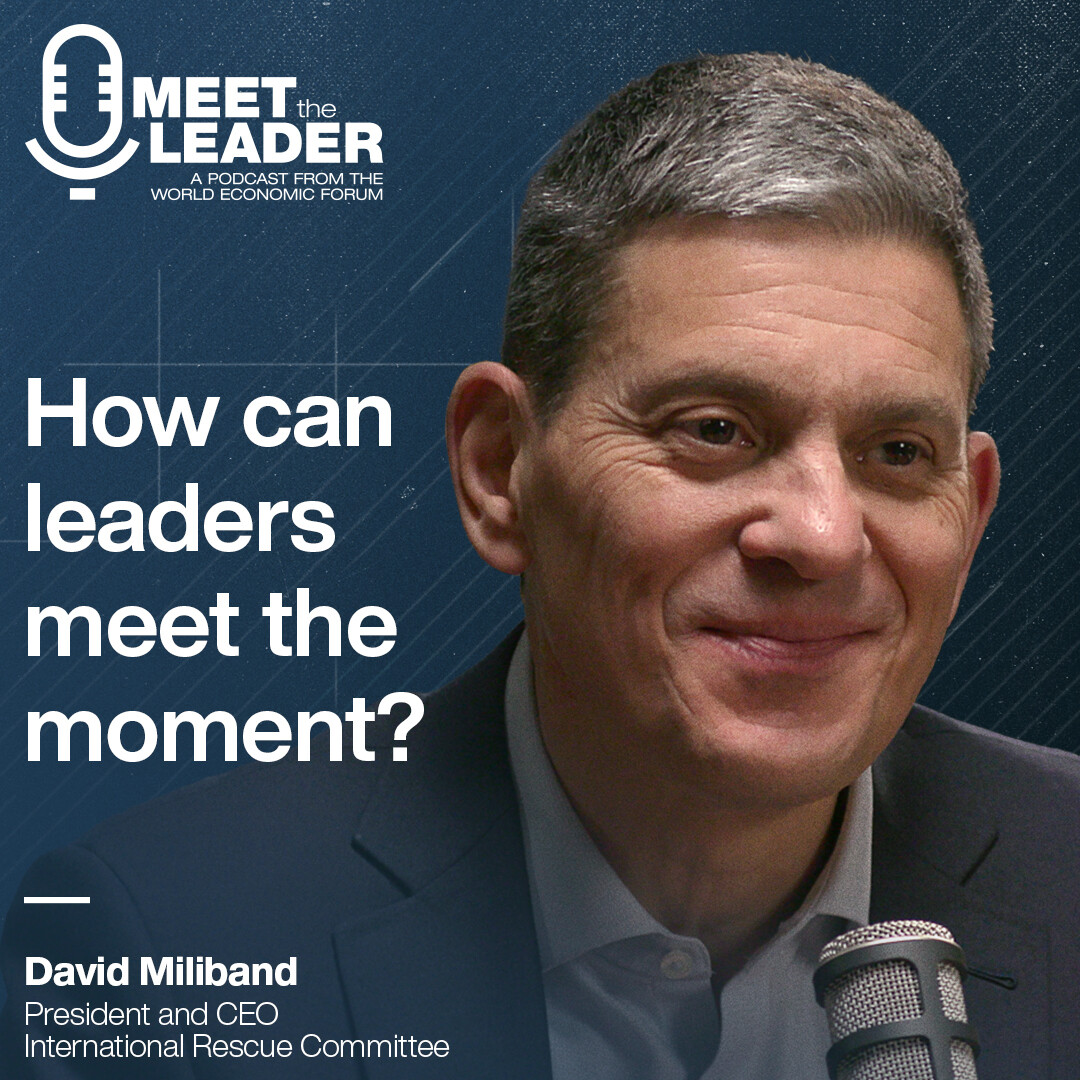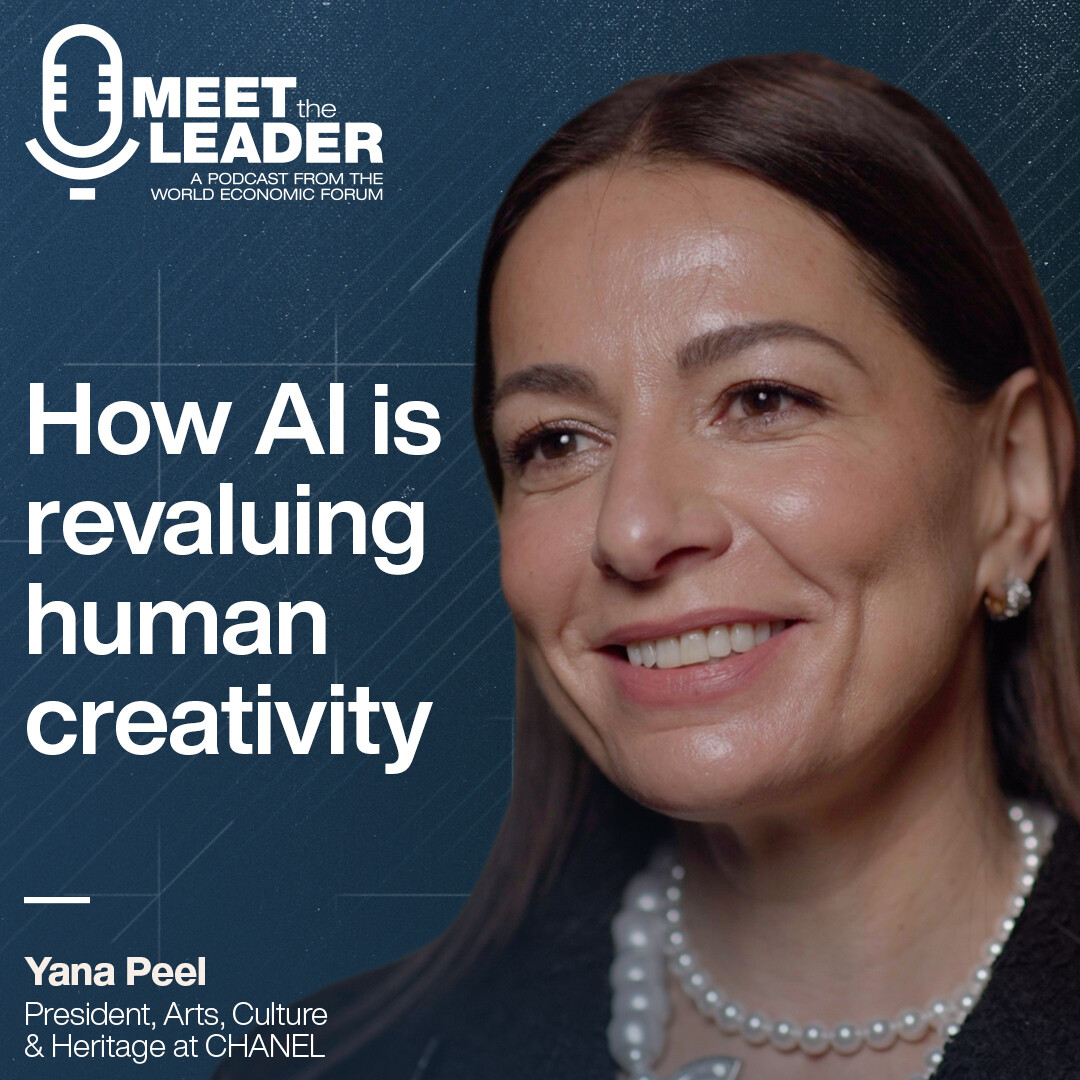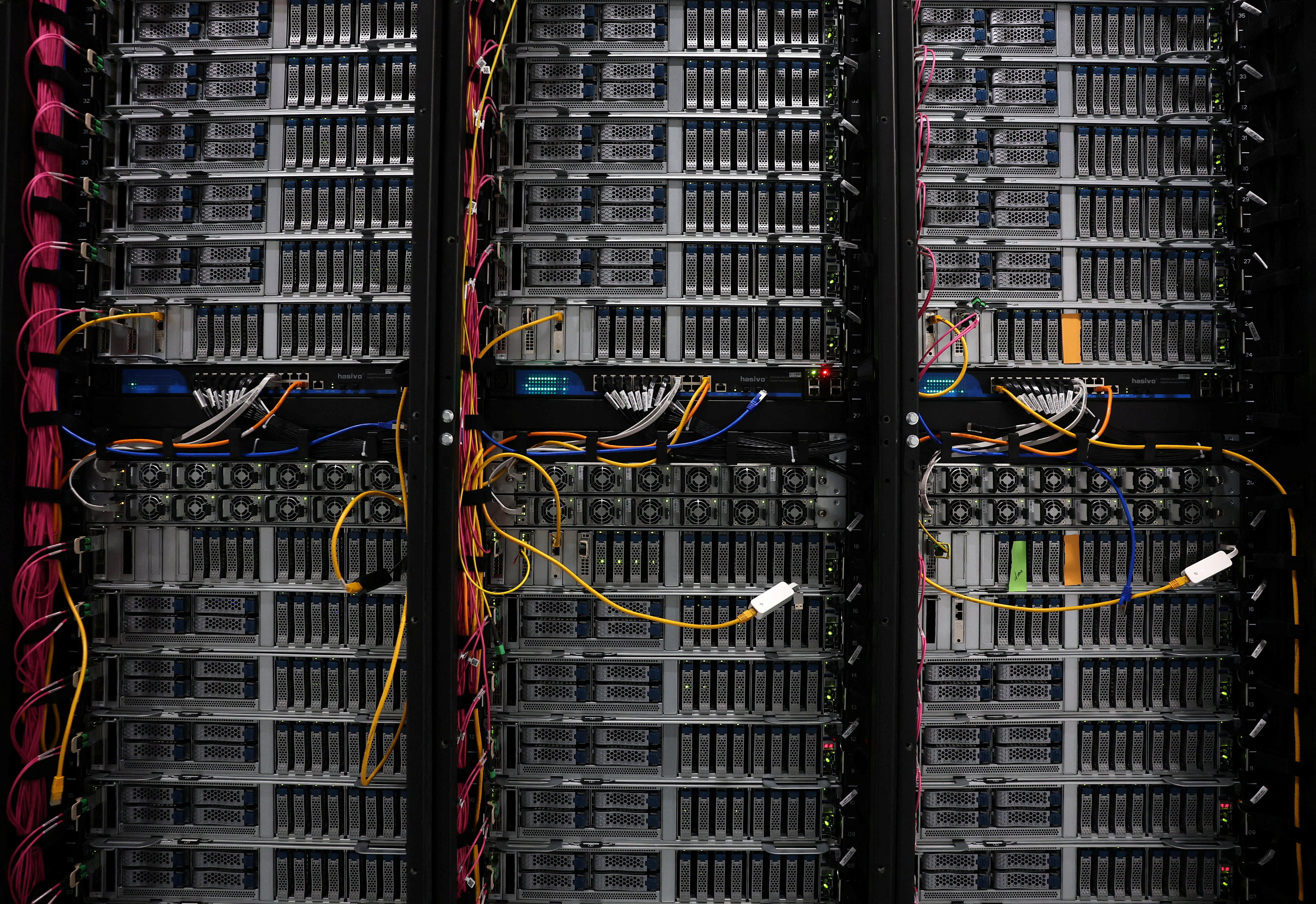Magic Leap's Peggy Johnson: The jobs Augmented Reality will change forever
Augmented reality will transform retail, manufacturing, surgery and even how we read a book. Peggy Johnson, CEO of augmented reality company Magic Leap shares how technology might evolve - and what could hold that progress back. She also shares key milestones from her decades-long career - including the surprising lesson mobile ringtones taught her about making big breakthroughs possible and how - as an introvert - she found ways to get her ideas heard.
Subscribe on any platform: https://pod.link/1534915560.
Join the World Economic Forum Podcast Club.
Transcripción del podcast
This transcript, generated from speech recognition technology, has been edited for web readers, condensed for clarity, and may differ slightly from the audio.
Linda Lacina, World Economic Forum: Welcome to Meet the Leader, a podcast where top leaders share how they are tackling the world's toughest challenges. Today's leader: Magic Leap's Peggy Johnson. She'll talk about augmented reality, the ways it will change how we work and live and the shifts she's excited about the most.
Subscribe to Meet the Leader on Apple, Spotify and wherever you get your favourite podcasts. And please take a moment to rate and review us. I'm Linda Lacina from the World Economic Forum, and this is Meet the Leader.
Peggy Johnson, Magic Leap: You have something to say. Remember, you have something to say when you go into a room.
Linda Lacina: Peggy Johnson is the CEO of Magic Leap, a company helping to pioneer applications for augmented reality (AR), a type of technology that integrates in real time digital information with a user's environment. This technology is already changing things like how workers are being trained, but it could also revolutionise everything from how doctors approach surgery to how you read a book.
I talked to Peggy at the Annual Meeting in Davos this January about augmented reality's potential and the changes that could come to how we work and live that might surprise us.
She also talked a little about her career in tech and the time she hit a wall, like an early role getting buy in for something we take for granted today: one of the first downloadable mobile app stores. She shared what that experience taught her about starting small to pave the way for big transformations.
And as a woman in tech, she also talked about what it was like often being the only woman in the room. That experience helped her develop a range of methods to build support and get her ideas heard. It also stressed to her the importance of women about the opportunities available in engineering and how those simple conversations can be key to getting more women to join the sector.
She'll talk about all of that, but first she'll get us started with more on Magic Leap and augmented reality.
Peggy Johnson: Magic Leap makes a head-worn device. It's an augmented reality headset. And essentially augmented reality is: You still see your physical world when you put the device on and then we intelligently place digital content in that physical world. So, it's kind of a merging of your physical and digital world in front of your eyes.
Linda Lacina: A lot of people would be surprised at the applications of AR and what's being made possible right now. What kind of solutions are Magic Leap making possible?
Peggy Johnson: So, we're focussed on a small number of solutions right now in areas where the industries are already wearing something on their eyes, oftentimes. So, things like health care, public sector and defence and manufacturing.
Largely they encompass use cases like training. It can really make a training scenario come to life. Anything that you want to visualise in 3D, those are the sorts of things and that the state of the technology today that we're focussed on.
So, for instance in manufacturing, we are helping with adding to a factory worker’s ability to do their job, whether it's more efficiently, quicker, less cost. Having the addition of this digital content can help them do their jobs better.
Linda Lacina: How does it help them do their jobs better?
Peggy Johnson: Largely what we do is, if they are first new to the job, it can onboard them more quickly. We have a company called PBC Linear in the Midwest, in the United States, that's been onboarding new factory workers in a timeframe that's about 80% less than when they used to train them inside of a classroom. What it allows them to do is put the factory workers out on to the factory floor much more quickly and they have the ability to, for instance, walk up to a machine that's gone offline. They can see a digital twin of the machine overlaid on the actual physical machine with arrows and pointers to help them get that machine back online again. If they run into a problem, they can do what's called calling in an expert and they can communicate to someone who's physically not there, who can see what they see. So if they get to a gauge and there’s something puzzling about that, they can call in an expert who can, actually, it's as if the headset’s on their eyes and they can see what that person on the factory floor is seeing.
Linda Lacina: And the bigger picture. Why is it so important to make sure that you can onboard people quickly and get them moving and you get that momentum so fast? Why is it so important?
Peggy Johnson: Well, it's interesting. If you talk to manufacturing companies today, in fact, we were associated with advanced manufacturing here at the World Economic Forum. You know, you think what is your biggest problem? Is it supply chain? You know, what are the issues they're having? They’re like, no, we can't hire factory workers. And so one of the biggest issues they're having is finding people and bringing them into the door and getting them up and running as quickly as possible. I think previously a factory job doesn't look as attractive these days as perhaps it did our grandparents. But this gives them a digital tool that allows them to, you know, have the same access to digital tools that you and I might have with a PC on our desktop. They now have a PC on their eyes. And so there's something very empowering about it and it makes it attractive to new factory workers coming in and a job that, you know, looks interesting and part of the modern world. And so that's been a plus.
But then it does allow them to retain factory workers because they feel more empowered and they feel empowered from day one with the device.
Linda Lacina: You mentioned digital twin. And just for people who don't know that term, just level set for those folks.
Peggy Johnson: Sure. So, you can make a digital twin of any physical thing. And in this case, if there's an automated machine, a physical machine on the factory floor, we can and using software from a number of companies, create a digital twin of that same machine, which basically is an overlay that your eyes see on top of the physical machine. And what it can do is it can give you the stats of something going on inside the machine. There can be a red alarm or light that says there's a problem and it's over here on the machine. So, it actually gives you more information about that machine than just what your eyes can see. So, it's pulling data from systems and monitoring that and then presenting that to the user who previously, if you're just looking at the machine, you might not have that same amount of data.
Linda Lacina: And that digital twin technology technology's also being used with a project at Lowe's, correct?
Peggy Johnson: Correct. Lowe's has been working with Magic Leap and also Nvidia’s Omniverse, which is a software platform that Nvidia has been working on that has a number of tools, not the least of which is the ability to present digital twins to Lowe's associates on the floor of a Lowe’s store. So, the associate now can walk down the physical aisle of the store and if there's something missing with the device there can be a digital image of what needs to go there. And then if the associate doesn't know where that is stocked in the back, it can also help the associate find where the supply is so they can go get it and put it into that empty spot. So, it just gives them an extra tool for doing their job more efficiently.
Linda Lacina: Do you think that people are surprised by the different ways that AR is changing basically how we work every day? I mean, these are very specific jobs, but everyday jobs, manufacturing, retail, you know, people wouldn't really think that this technology would be coming into play. What do you think is surprising to people about that?
Peggy Johnson: Well, I think one of the most surprising areas is what it can do in health care. So, when you think about a surgeon in the operating room, they have a number of physical assets that help them do their job in the operating room. This gives them one more, and it actually gives them quite a bit of access to data so the surgeon can look down at the patient- let's say they're doing knee surgery. Overlaid on the patient can be digital content that shows perhaps where the surgical pathway needs to go, the incision needs to go. They can have a virtual screen hanging up wherever the surgeon finds the most comfortable. Rather than fixed in the surgical theatre, it's actually a virtual screen. They can put it wherever is comfortable. If a surgeon doesn't want to move their head much from taking their eyes away from the patient, they can glance up and look at a virtual screen wherever they find most comfortable. They can hang that screen.
The patient's vitals can be displayed in front of the surgeon, and the surgeon can actually take it into the operating room now, because we are 60601 certified, which allows them to bring into the operating room. So, it has all of that, the heat and the other electrical characteristics that are required to have something in the operating room. I think it's game changing for surgery. I think it'll really change how surgery is delivered.
Linda Lacina: It's really interesting, too, because especially when you talk about surgery, again, people aren't picturing this in all these different environments. What do you think might be possible even in sort of in the near future?
Peggy Johnson: I think what you'll see happen is a trajectory that's very similar to mobile phones. So mobile phones were big in the beginning but they served a purpose. They helped, for instance, if you were a salesperson working out of your car and you had to call the office three times a day, you had to find a parking spot, make a phone call, then with mobile phones, you could make a call. And the phones were bigger for sure. They were more expensive, but they did serve a purpose. There was a return on investment for companies at that time.
That's the trajectory that we're on with augmented reality. We've chosen just a handful of verticals to focus on because there's a return on investment for the product today going.
Going forward five to 10 years, you're going to see the product do the same thing that the mobile phone did. It's going to get smaller, lighter, it'll likely assume more of a glasses format and then eventually, maybe in the latter half of that time from ten years or so, there's actually contacts that we are seeing early days now. There are several companies that are focussed on making augmented reality contacts.
So it could be that, at some point, we put on augmented reality contacts and that's just how we go through our day with intelligent digital content in front of our eyes.
Linda Lacina: What are you most excited about when it comes to the potential or even the likely applications of AR?
Peggy Johnson: Well, I think it has a real opportunity to change, for instance, education. Anything where you read in a book, it can really come to life when you put a 3D image. So, think of your chemistry classes in high school. Now you can have a molecule in front of your eyes, you can walk around it, you can open it up, you can look inside. That type of imagery I think is going to have such an impact on a variety of fields, but education in particular.
Linda Lacina: What could hold that back?
Peggy Johnson: I think a couple of things can hold it back, and we've seen progress in these areas recently. But one is the ecosystem. So, you need to have good content to run on these devices and that content has to be able to take advantage of the 3D capabilities that can be leveraged with these devices. So, we need developers developing content for augmented reality devices. So that's one and we're working hard on that at Magic Leap to expand that.
The other is really just the interoperability. So much like again, the early days of mobile phones, you want you want phones from different manufacturers to be able to talk to each other. I really don't think a walled garden is the right way to go with this technology because you'll just limit it. And so, we're very focussed on an open platform and ensuring that we interface to as many software platforms as possible on Magic Leap.
Linda Lacina: What sort of capabilities need to be built to sort of ensure that that continues, that there is more openness? What needs to happen?
Peggy Johnson: There needs to be communications between all the companies that are engaged in the development of augmented reality. Those communications are going on now. I think we may have learned from the early days of the mobile phone. And so going into this new technology, this still somewhat nascent technology, we will see more interoperability I believe from day one.
Linda Lacina: There's not enough women in tech. What is your approach to mentoring and helping pave the way and support new generations of leaders within the tech space?
We need to show young women what exciting opportunities are out there with a STEM career. They need to be able to see themselves.
”Peggy Johnson: So, I spend a lot of time mentoring. I spend a lot of time talking to young women, showing them that engineering, STEM careers are attractive careers. They have awesome things that you can do in these areas.
Somewhere along the line I had a talk like that from actually two administrative assistants in the engineering department. I was delivery mail. I was a business major, and I was delivering mail in the engineering department, and they talked me into changing my major. But they showed me what you could do with a career in STEM. In this case in particular, electrical engineering, which was what my degree was.
I had never really been able to see myself in a career like that. Very fulfilling. I remember they said, 'the world will be your oyster,' and it really has been. We need to show young women what exciting opportunities are out there with a STEM career. They need to be able to see themselves. That's one of the reasons we do have less women, because when they look into engineering, they don't see a lot of women. And so, we need to continue to open that funnel up and get more. We need them. We're definitely short of engineers across so many fields and it's kind of an untapped community. And so, I do spend a lot of time speaking with young women about the opportunities in this area.
Linda Lacina: In so many sectors, not just tech, there's a number of sectors where women are not well represented. And maybe sometimes they can get in, but maybe they don't stay. How do we keep them in as well? How do we retain these women technologists?
Peggy Johnson: Yeah, it can be a lonely place. It was for me when I first started out in engineering. Oftentimes I was the only woman in the room. I think the best way to keep them there is when they feel comfortable in that environment. And that means getting to use their voice, ensuring that they're heard in a meeting full of big voices. If there's someone, as I did, who has a quieter voice and a bit of an introvert making sure that their voice is also heard, and I think that goes a long way in helping people feel comfortable in an environment and included, and that their opinion is valued. And so, we need to do a little bit more of that to ensure that women who join these fields stay in these fields.
Linda Lacina: There's an exhibit here. The Only Woman in the Room here at Davos. It's apropos that you'd say that. And it struck me, looking at all those images, of these women throughout history that’d found themselves, as these sort of inflection points - how interesting, maybe challenging, how do you navigate that? In your experience, what was a way that you made sure that your voice was heard or that you could make an impact? Did you have any kind of approaches to make sure that you could kind of position yourself to be heard?
Peggy Johnson: That's a good question. And for me, being a bit of an introvert, I would say to the leader of that meeting oftentimes beforehand, hey, just remember to throw me the ball, to use a sports analogy, because I would struggle at times to find an opening in a conversation of very big voices in a room. If I couldn't get my word in in that meeting, I sometimes would go visit afterwards in someone's office and say, you know what, what I wanted to say in the meeting is this. And then I learned how about I just tell them ahead of time, throw me the ball in the meeting. Because oftentimes it's hard to break in. And that goes for women and men. And, you know, anybody has a hard time taking the floor in a meeting. So, it's good that the leader knows to do that. And oftentimes just giving them that input and that feedback is helpful.
Linda Lacina: You've had a number of leadership roles, in your career. How do you think you've changed? Is there something that you do now as a leader that may not have occurred to you when you were just starting? Anything that comes to mind?
Peggy Johnson: You know, one thing, and I probably learned this about halfway through my career, was just to be myself. I struggled in the beginning to try and be like everybody else at the table. And that was uncomfortable for me. I would sometimes go into meetings and, like pound my hand on the table like I'd seen others do. And when I did that, that was startling for everybody because they were like, what's going on? Why are you mad? And then it's like, why am I doing that? At some point I just was like, this is who I am and I need to be accepted as I am. And that made a big difference. That's really when I felt that my career started to take off, when I was just myself and not trying to be a personality that the others were depicting. If I wasn't that I wasn't going to try and be that. I just had to be myself. That's when I was most productive.
Linda Lacina: Are there tools for that? I think everybody will always say, I'm being myself. I'm the only me I can be. But we may not realise how we are mirroring or mimicking the behaviours that are around us. What should they be looking for that shows that maybe it's not working or it's not their sort of uniqueness?
Peggy Johnson: One thing I would say is everyone should just go in to a meeting, in this case it's the venue we're talking about, and accept people for who they are. I've had in my career women who are loud and opinionated and they've been told to tone down. And so I would just say for everyone, go into a meeting with sort of an open mind and accept people from whatever, from wherever, they're coming from. You're going to get the most out of those people if you do. They're going to be the most productive. You're going to get better outcomes. But if you try and constrain people into something that they're not, it's not good for them and it's not good for really the business impact, it will be reduced because you're not allowing them just to be who they are.
Linda Lacina: You work in technology. Technology is about big bets. It's about looking to sort of create something that maybe there's not a market yet for. Maybe no one's really envisioned how would we use this? Has there ever been a time where you've maybe hit a wall or everyone's saying, well, why would we do that? and it worked out, but there was a moment where you weren't sure that it was. What did you do next, I guess, in that moment?
Peggy Johnson: I have very vivid memories of in the early days when I was back at Qualcomm, we were making mobile phones and we actually came up with the first downloadable app store years later. Apple coined the term, but we actually built internet protocols into the phone. We had the ability to download software really for the first time onto a phone before that was all really in the hands of the operator, the carriers who were running the system. And we thought it was a fantastic innovation and who wouldn't want to download software onto their phone?
I remember going in front of one of the big US operators and telling him that we had built this into the phone and they said, why would anyone want that? A phone is a phone. You need to make phone calls with the phone. That was all they could see. The fascination for them was you didn't need to go to a phone booth anymore. You could have a phone in your pocket and that's all it needed to do.
And we could see the future, but it was clear they couldn't. And the breakthrough was when we said, you can download ringtones, you remember you could download ringtones in the beginning, and that was what sold it. They said, this is fascinating. You can download ringtones and we can charge for them. We love it. So that was like the beginning, the very beginnings, of people seeing the value of the internet on a phone. You know, when you look back now, it sounds kind of silly because but that was the start of what is now a PC in our pockets.
Linda Lacina: It's sort of finding a little way to give something that they understand, something that they need?
Peggy Johnson: That has value, right. Because they were able to charge for that. And that was the breakthrough. And I say it's very similar in augmented reality. If we don't provide a return on investment, no one will buy the device. So, we have to prove that there's value today in the state of the technology today for someone to make a purchase like that. And we can do that in training, in 3D visualisation.
Linda Lacina: In those moments, in those meetings, like learning that, 'hey, we have these these amazing things you could do' and they're like 'we want ringtones.' What did you take rom that, that you use today?
Peggy Johnson: You know, I think it's okay to start small and because we knew we'd eventually get them there and we started big, we thought, why don't they understand? But then when we backed up and said, look, if this is the way through, then this is the start of the internet in our pocket. And once we got comfortable with that, then it became, 'wow, you could download all sorts of applications.' And then we had a whole app store that, across all the carriers, we downloaded something like 3 billion apps on the day that Apple's App Store first started. So, we had created and had a very innovative app platform. We had to go through the trajectory. We couldn't have just started at the end game. No one would have bought it, I think.
People tend to dismiss intuition. You can't 100% rely on it, but it certainly shouldn't be ignored.
”Linda Lacina: Is there a trait that you depend on as you were trying to design these solutions so that they can have momentum or move forward? What do you depend on to make that stuff work?
Peggy Johnson: I am a big fan of intuition and a gut feeling about something and not ignoring those things. I guess I did see that, going back to my mobile phone example, I could see that we weren't getting the breakthrough that we wanted with the entire system. And so, when we peeled it back and I could see that it was resonating, that's when we said, 'okay, we're going to go full force with these ringtones.' I think in general, people tend to dismiss intuition and, you know, those feelings that you have that you're on the right path. You can't 100% rely on it, it has to be a mix of the technology and the intuition, but it certainly shouldn't be ignored.
Linda Lacina: Has there ever been a piece of advice that you've been grateful for?
Peggy Johnson: Oh, wow. Interestingly, I had one of my first managers, even in this almost all-male world that I started when I started my engineering career, I had a woman manager way back in the beginning, and she was the one who really encouraged me to use my voice and to not let a moment go by and perhaps I didn't get my opinion across. It was hard for me to do, as I said, but she was the one who said, you have something to say. Remember, you have something to say when you go into a room and deliver it and it'll be accepted. And she was right. She was wonderful.
Remember you have something to say when you go into a room. Deliver it and it'll be accepted.
”Linda Lacina: Is there a book that you recommend?
Peggy Johnson: I usually tend to read about ten books at once. Fiction, non-fiction, a little bit of everything. A really interesting book right now called Apocalypse Never. It's by a man called Michael Shellenberger, I believe. And it's just looking at rather than an alarmist view to climate change, a very scientific view of climate change, and just being an engineer. That resonates with me. It's fascinating. It's a wonderful book.
Linda Lacina: What would people take from it if they read it?
Peggy Johnson: I think that you really have to look at and understand the data around anything. Again, my engineering roots kind of make me align with that view rather than a headline or something that, you know, is meant to create fear. It's like, no, peel back the onion a bit and try and understand the underlying data and the trends. And that tends for me to be a more believable approach to first what the problem is and then what a solution can be.
Linda Lacina: Everyone's going to leave [Davos], they’ll go back to their governments, their non-profits, their companies. What is the first thing that they should do to make sure that the spirit of collaboration and inspiration — it’s very inspiring to be at Davos — what's a practical thing they can do to kind of keep that spirit going in their organizations?
Peggy Johnson: That's an interesting question and I think, you know, this whole idea of globalisation, while it's gotten battered over the last few years and just with events around the world, there's so much opportunity in globalisation and collaboration across countries, across industries, across verticals. If they just took that, the spirit of collaboration away, I think, and just fixed one thing in that area, I think there's a lot of value there for people.
Linda Lacina: That was Peggy Johnson. Thanks so much to her and thanks so much to you for listening. A transcript of this episode and my colleagues’ episodes. Radio Davos and the Book Club podcast is available at wef.ch/podcasts.
If you liked that episode, check out episode 65 from December 2022, where I talk to CEOs from companies like Tech Mahindra, SandboxAQ and WorldQuant about how quantum sensing, the metaverse and data will further transform our lives.
This episode of Meet the Leader was presented and produced by me with Juan Toran as studio engineer, Jere Johannson as editor and Gareth Nolan Driving studio production. That's it for now. I'm Linda Lacina with the World Economic Forum. Have a great day.










